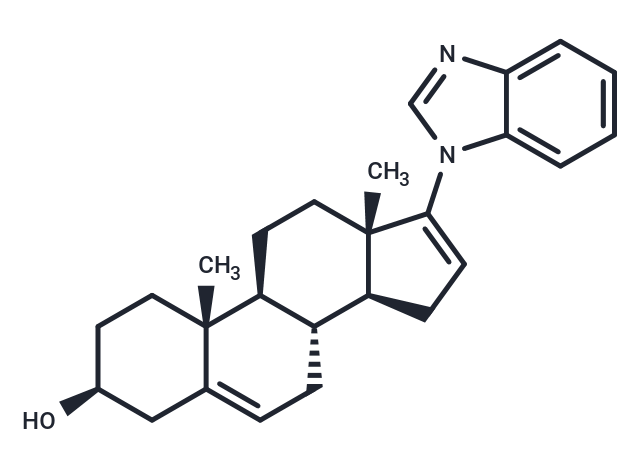- Remove All
 Your shopping cart is currently empty
Your shopping cart is currently empty
Galeterone
Galeterone (VN 124) is an orally bioavailable small-molecule androgen receptor modulator and CYP17 lyase inhibitor with potential antiandrogen activity. Galeterone exhibits three distinct mechanisms of action: 1) as an androgen receptor antagonist, 2) as a CYP17 lyase inhibitor and 3) by decreasing overall androgen receptor levels in prostate cancer tumors, all of which may result in a decrease in androgen-dependent growth signaling. Localized to the endoplasmic reticulum (ER), the cytochrome P450 enzyme CYP17 (P450C17 or CYP17A1) exhibits both 17alpha-hydroxylase and 17, 20-lyase activities, and plays a key role in the steroidogenic pathway that produces progestins, mineralocorticoids, glucocorticoids, androgens, and estrogens.

Galeterone
| Pack Size | Price | Availability | Quantity |
|---|---|---|---|
| 5 mg | $52 | In Stock | |
| 10 mg | $79 | In Stock | |
| 25 mg | $143 | In Stock | |
| 50 mg | $243 | In Stock | |
| 100 mg | $397 | In Stock | |
| 200 mg | $593 | In Stock | |
| 1 mL x 10 mM (in DMSO) | $58 | In Stock |
Product Introduction
| Description | Galeterone (VN 124) is an orally bioavailable small-molecule androgen receptor modulator and CYP17 lyase inhibitor with potential antiandrogen activity. Galeterone exhibits three distinct mechanisms of action: 1) as an androgen receptor antagonist, 2) as a CYP17 lyase inhibitor and 3) by decreasing overall androgen receptor levels in prostate cancer tumors, all of which may result in a decrease in androgen-dependent growth signaling. Localized to the endoplasmic reticulum (ER), the cytochrome P450 enzyme CYP17 (P450C17 or CYP17A1) exhibits both 17alpha-hydroxylase and 17, 20-lyase activities, and plays a key role in the steroidogenic pathway that produces progestins, mineralocorticoids, glucocorticoids, androgens, and estrogens. |
| Targets&IC50 | Androgen receptor:384 nM, CYP17:300 nM |
| In vitro | Galeterone is effective at preventing binding of [3H]-R1881 to the mutant LNCaP AR (T877A) with IC50 of 845 nM. Galeterone inhibits the DHT-induced proliferation of LNCaP and LAPC4 cells in a dose-dependent manner with IC50 of 6 μM and 3.2 μM, respectively. [1] Galeterone also inhibits the binding of [3H]-R1881 to the T575A mutant AR in PC3 cells with IC50 of 454 nM. Galeterone potently inhibits the proliferation of LNCaP and LAPC4 cells in the absence of DHT stimulation with IC50 of 2.6 μM and 4 μM, respectively. Furthermore, Galeterone treatment increases the degradation rate of the AR in a dose-dependent manner. [2] Galeterone potently inhibits the growth of the androgen-independent cell lines PC-3 and DU-145 in a dose-dependent manner with GI50 of 7.82 μM and 7.55 μM, respectively. Galeterone induces the endoplasmic reticulum stress response resulting in down-regulation of cyclin D1 protein expression and cyclin E2 mRNA. [3] Galeterone effectively inhibits proliferation of HP-LNCaP and C4-2B cell lines with IC50 of 2.9 μM and 9.7 μM, respectively. Galeterone treatment at 1 μM effectively inhibits androgen receptor activation in LNCaP cells (50%) and HP-LNCaP cells (70%). Galeterone decreases activation of the androgen receptor in both LNCaP cells and HP-LNCaP cells with IC50 of 1 μM and 411 nM, respectively, and down-regulates androgen receptor protein expression by 50% after 24 hour of treatment. [4] Galeterone reduces AR protein and mRNA expression, antagonizes AR-dependent promoter activation induced by androgen, and significantly reduces the phospho-4EBP1 levels. [6] |
| In vivo | Administration of Galeterone at 50 mg/kg twice daily is very effective at inhibiting the growth of androgen-dependent LAPC4 human prostate tumor xenograft, with a 93.8% reduction in the mean final tumor volume compared with controls, and it is also significantly more effective than castration. [1] Treatment of Galeterone (0.13 mM/kg twice daily) or Galeterone (0.13 mmol/kg twice daily) plus castration induces regression of LAPC4 tumor xenografts in SCID mice by 26.55% and 60.67%, respectively. Treatments with Galeterone or Galeterone plus castration causes marked reduction in AR protein of 10- and 5-fold, respectively. [2] |
| Kinase Assay | In vitro assay of CYP17: The in vitro CYP17 inhibitory activity of Galeterone is evaluated using rapid acetic acid releasing assay (AARA), utilizing intact P450c17-expressing E. coli as the enzyme source. It involves the use of [21-3H]-17α-hydroxypregnenolone as the substrate, and CYP17 activity is measured by the amount of tritiated acetic acid formed during the cleavage of the C-21 side chain of the substrate. IC50 value is obtained directly from plots relating percentage inhibition versus inhibitor concentration over appropriate ranges. |
| Cell Research | Cells are seeded in 24 well multi-well plates. Cells are treated with the increasing concentration of Galeterone in steroid free medium with or without 1 nM DHT (LNCaP), or 10 nM DHT (LAPC4) and allowed to grow for 7 days. The number of viable cells is compared by MTT assay (LAPC4) or XTT assay (LNCaP) on the 7th day. (Only for Reference) |
| Alias | VN-124-1, VN/124-1, VN 124, TOK-001 |
| Molecular Weight | 388.55 |
| Formula | C26H32N2O |
| Cas No. | 851983-85-2 |
| Smiles | C[C@]12CC[C@H]3[C@@H](CC=C4C[C@@H](O)CC[C@]34C)[C@@H]1CC=C2n1cnc2ccccc12 |
| Relative Density. | 1.28 g/cm3 |
| Storage | Powder: -20°C for 3 years | In solvent: -80°C for 1 year | Shipping with blue ice. | |||||||||||||||||||||||||
| Solubility Information | Ethanol: 19.4 mg/mL (49.93 mM), Sonication is recommended. DMSO: 19.4 mg/mL (49.93 mM), Sonication is recommended. | |||||||||||||||||||||||||
Solution Preparation Table | ||||||||||||||||||||||||||
Ethanol/DMSO
| ||||||||||||||||||||||||||
Calculator
In Vivo Formulation Calculator (Clear solution)
Dose Conversion
Tech Support
Keywords

Copyright © 2015-2025 TargetMol Chemicals Inc. All Rights Reserved.



